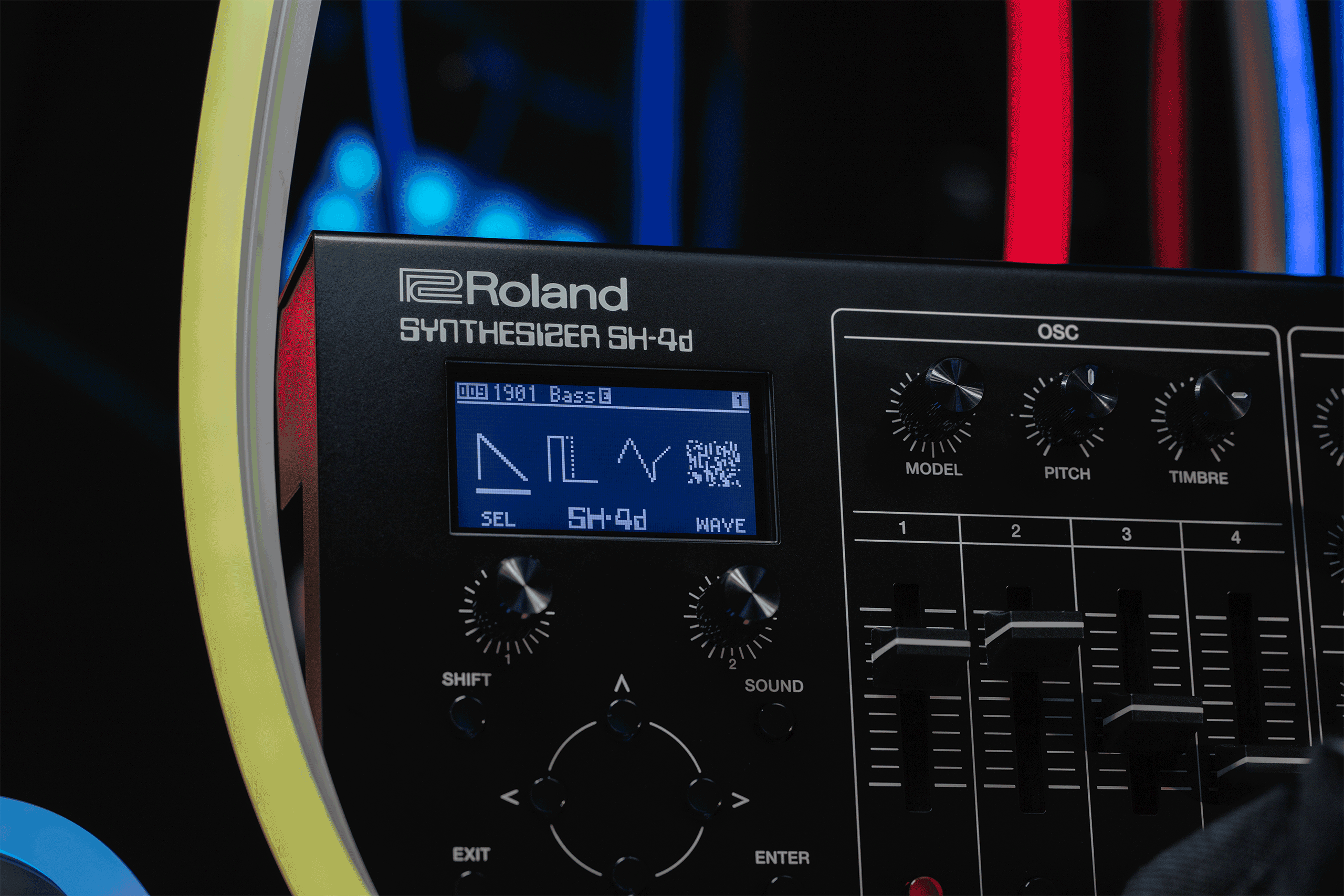The SH-4d Synthesizer is a versatile desktop powerhouse that draws on the legacy of Roland SH synths while pushing the sound design conversation in bold new directions. At the heart of the SH-4d are eleven new OSC Models that provide users with a broad spectrum of tones and textures, including analog synths, PCM-based and digital sounds—even an onboard-drum synthesizer. Explore these eleven oscillators and see where they lead on your synthesis journey.
SH-4d
The SH-4d Model allows users to mix up to four different waveforms, each with independent settings for tuning, pulse width, and more. This creates huge palettes of harmonic content to feed through the brand-new multimode filter. A super versatile analog-style model, the SH-4d gives you all the tools to build up powerful tones.
SH-3d
Take the SH-4d Model, swap out the fourth oscillator for an extra LFO, and you’ve got the SH-3d. The second LFO allows for deeper and more creative modulations to get the sound moving and grooving. Try modulating LFO1 with LFO2, vice versa, or both simultaneously.
SYNC
The sound of one oscillator synchronized to reset with another creates a familiar and powerful harmonic effect. Often used for lead sounds, it can also add distinct character and movement to polyphonic tones. With the SYNC Model, you can choose from 9 different waveforms, with the sliders acting as a pitch envelope to quickly create sweeps and swells.
SH-101
The venerable SH-101 is famous not only for its massive basses, cutting leads, FX, and plucks but for how quickly one can create these sounds with the clear and straightforward interface. The SH-101 Model re-organizes the oscillator section to mirror this interface. This allows for quick mixing and programming of oscillator shapes and noise.
JUNO-106
Lush chords, funky sub basses, and chorus-laden good vibes gush out of the JUNO-106. This model boasts the familiar oscillator section controls, so users feel at home. At the same time, it can also go deeper than the original.
CROSS FM
Glassy, smooth, clangorous, crunchy. The CROSS FM Model can create classic sounds like Tine EPs and Xylophones by using sine waves and more aggressive sounds like raunchy basses and FX by changing which waveforms it uses for the carrier and modulator. At the same time, this model also allows for expanded tonal exploration with additional waveform and modulation settings.
RING
The RING Model, at its core, uses two oscillators with selectable waveshapes. By changing the tuning ratio between them, the model creates inharmonious tones often used for FX and percussion. However, it doesn’t stop there. The Shape parameter applies further morphing and allows for mixing in raw waveforms. There is also additional frequency modulation to put things over the top.
WAVETABLE
With the WAVETABLE Model, traverse 31 unique selectable wavetables, each with smooth morphing for position. When using the different waveshapes in a static manner, there are almost 4000 waveforms available. Morph through the wavetables using some of the modulation sources, including the auxiliary envelope on the sliders, for beautiful, shifting tonalities. These can be soft and subtle, metallic and brash, or anywhere in between.
CHORD
Chord memory holds a special place in synthesizer history. The sound of parallel moving chords, played with one finger on the keyboard, appears on many classic house and techno tracks. The CHORD Model takes this concept further and gets results quicker. It offers 19 selectable chord types with multiple voicings for each. Waveshape and pulse width are also available in the oscillator section. Here’s a pro tip. With the deep sequencer on the SH-4d, you can program different chord types and voicings on any step.
DRAWING
Get released from the shackles of shapes, the constraints of cosines. Be the commander of curves, the sergeant of slopes. With the DRAWING Model, draw original custom waveshapes using the sliders, buttons, and encoders. This functionality opens countless possibilities for new shapes that, if rough around the edges, can even get smoothed out with the Timbre knob. Paired with the new SH-4d filter, adventurous tonalities abound.
PCM
PCM synthesizers helped define the sound of the late ’80s and early ’90s. These instruments utilized samples of acoustic instruments instead of analog or digitally generated waveforms. The PCM Model offers 53 unique PCM waves with up to four layers. This model allows for novel combinations that harken back to the old school while presenting new creative possibilities.
RHYTHM
The RHYTHM Part on the SH-4d follows the spirit of the eleven oscillator models: quick, hands-on creation. Each kit consists of 26 drum instruments that users can program as their own synthesizer voice. Creating a sound starts by selecting one or two of 481 waveforms, many of which are killer off-the-shelf drum hits, ready to go.
Further Adventures in Sound
From there, it’s possible to adjust the balance of each waveform, apply separate tuning, a pitch envelope, and even frequency modulation. A fully-fledged multimode filter, along with Amp and Filter ADSRs, is available for each of the 26 instruments. Create kicks and toms using classic waveforms, snappy hits and snares using noise and filter resonance, FX, synth sounds, and much more. Or, load up some classic Roland X0X instruments and let it rip.







